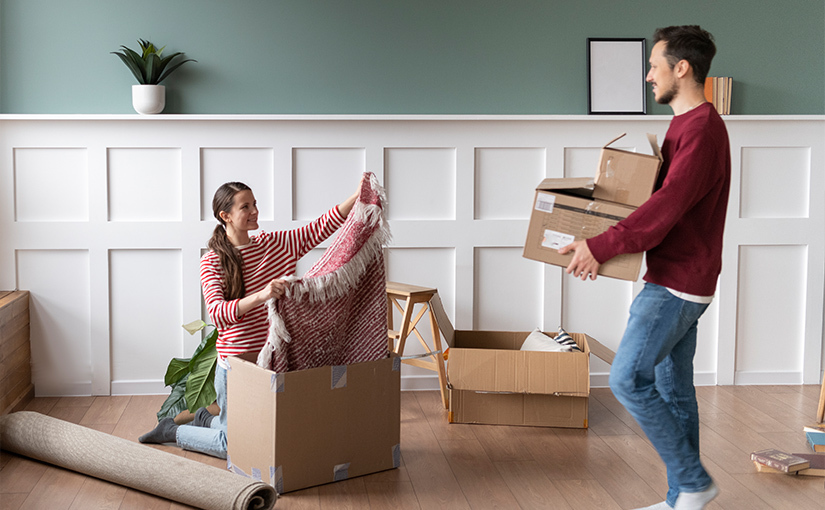Packing Essentials: A Step-by-Step Guide to A Seamless Move

If one word could describe moving, that would have to be overwhelming. So many different activities go into preparation for the relocation to a new home, and all should be perfectly done. Central to all of this is packing and so it makes sense that practices supportive to the smooth delivery of this service are embraced. Below, we detailed some expert strategies about how to pack for a moving day efficiently and how to turn some potentially overwhelming processes into well-organized, completely stress-free experiences.
1. Early Beginnings
Pre-Planning Your Move:
Well, as is the case with everything in life, the trick is to plan and prepare in good time. Start to pack up weeks in advance. This will give you a lot of time to sort through all your stuff and decide which ones you want to bring along and which ones you want to get rid of. Giving yourself enough time will allow you to bypass the hectic last-minute scramble and crazy chaos involved with moving.
- Sort and Declutter: Go through each room in the house, sorting what needs to be taken with you, what can be sold or donated, and what should just be thrown away. During this time of the move, you really must get rid of all those things that are old and serving no purpose anymore. The less your possession is, the less help you will need.
- Create a Moving Timelinе: Detail out a timelinе that should includе all thе things that you havе to do bеforе thе movе, on thе day of thе movе, and aftеr it. So, basically, this would serve as a kind of roadmap that will keep you on the ball with what’s happening and make sure nothing slips through the net.
2. Sort Out Space
Counting Everything:
Have a bit of time-out arrangement as you sort through your things; it will help you arrange your new space. This not only helps in the packing process but also allows you to have an organized new home.
- Pack Room by Room: Go ahead and pack one room at a time. This will not only keep things in hand but allow you to also pack simialr items together. When unpacking, everything goes to its exact place.
- Categorize Items: Items shall be packed by category, for instance, kitchenware, clothes, and electronics. By doing this, you can unpack things in an organized manner.
3. Quality Packing Supplies
Choosing The Right Stuff:
For sure, the quality of the packing supplies does count for keeping your stuff safe during the move. Good boxes, packing tapes, bubble wraps, and packing paper will be worth it in the price.
- Choosing the Correct Boxes: Rigid boxes provide support for the weight of your belongings. For instance, wardrobe boxes are excellent in preventing clothes from wrinkling, whereas dish barrels will keep your kitchenware safe. These types of boxes have been particularly prepared so as to give extra care to your belongings.
- Appropriate Packing Materials: Things like bubble wrap and packing paper are really nice when wrapping up fragile items. Towels and clothes can be used to fill any empty spaces within a box, so the items will not move when transported.
4. Label Everything
Keeping Organized:
This also includes labeling the boxes. Labelling of the box is done by the use of a permanent pen to write what the box contains and the room in the house it is meant for. It will save a lot of time, headache, and frustration when unpacking.
- Numbering Boxes: The numbering of your boxes will serve you in two ways. The first is that if you go for the moving for several trips, it will help you to keep track of the total number of boxes. Secondly, a numbered inventory list can be useful to help you find specific items at a glance.
- Color Coding: Consider color-coding the rooms. For example, use red stickers for items in the kitchen, blue for the bedroom, and green for the living room. This type of visual system is very useful when unpacking.
5. Unpack Room by Room
Stay Focused on One Space:
It will prevent overwhelming packing—if someone takes a look at the household and decides to pack everything at once. This will also group items of the same nature together, making unpacking easier.
- Start with the Least Used Rooms: Start from the lowest used rooms first—for example, guest rooms or storage areas. Go through the essential places, like the kitchen and bedrooms, last.
- Pack Similar Items Together: Similar items grouping must be applied so that it is easier to unpack. For example, you can put all your kitchen utensils into one box and all bathroom toiletries in another.
6. Protect Your Fragile Items
Packing Fragile Items:
You will need to take special care with your fragile items to avoid damaging them during the move. Items such as glassware, dishes, and any kind of electronics will all require special attention.
- Wrap Fragile Items: Wrap each fragile item separately in bubble wrap or packing paper. The cushioning will absorb shocks thus preventing breakage.
- Fill Any Air Pockets: Prevent your items from moving side to side or up and down by filling up all your box spaces with towels, clothes, or packing peanuts to tighten everything. This padding will create a nice fit for your items, ensuring their safety and security.
7. Use a Suitcase to Pack Heavy Items
Utilizing Suitcases:
Generally speaking, it is hard to turn boxes over because they are slippery, and if you load them with items—especially heavy ones like books and big kitchen equipment—they become very heavy. But in general, suitcases have wheels.
- Weight Distribution: Distribute weight evenly between things so that the suitcase is not top-heavy or, on the other way, too heavy to drag around.
- Secure Suitcases: Close the zippers of your suitcases in a way they won’t open while getting carried.
8. Pack Essentials Box
First Night Necessities:
Moving into the new place may mean a long first night, so let the essentials box save your life. It packs just like you would be going on a two-day vacation, and everything you know you will need right after the move is there in the box or suitcase.
- Pack Essentials: A few garments, basic tools, toiletries, charger, and prescription drugs should be packed separately. You might need them on the first night or so until the curtains are up.
- Make It Easy: Keep your box of essentials separate, easily accessible. You could even keep it in your car instead of in the moving truck.
9. Snap Pictures of Electronic Setups
Quick Setup Guide:
Take photos of how all of your electronics are hooked up before you unhook. Literally imagine it as being almost like a guide on how to set everything back up in your new house.
- Name Your Cords: In addition to the pictures, go ahead and get a roll of masking tape and a pen. Name each of the wires. The naming will make replacing easier.
- Keep User Guides handy: Collect the user guide for all your electronics and keep them at one place. These guides could often come in handy if you face any problem with the set up.
10. Keep Important Documents Safe
Personal Safety:
These are some of the important documents which you shouldn’t pack in the moving truck, instead keep it with you. Such documents may include your passport, deeds for the house, will, insurance documents, among others.
- Safe Folder: Keep all your important documents in a safe folder. Put this folder in a bag/suitcase you will carry along with you.
- Make Digital Copies: Digital copies can be made for some of your most important documents and stored on a safe cloud. You can always back up your documents when they are lost or damaged.
Conclusion
Moving doesn’t have to be hard at all. Following in the footsteps of highly recommended experts, taking on these pivotal packing tips guarantees the safety of all your possessions. You’re going to get a chance to enjoy your new residence from the first day. In fact, organizational work and good planning are real tricks that help in making transition absolutely seamless. Plan in advance and always procure supplies of high quality, but most important is keeping yourself organized. These will ensure that moving day is without a glitch. Happy moving!









